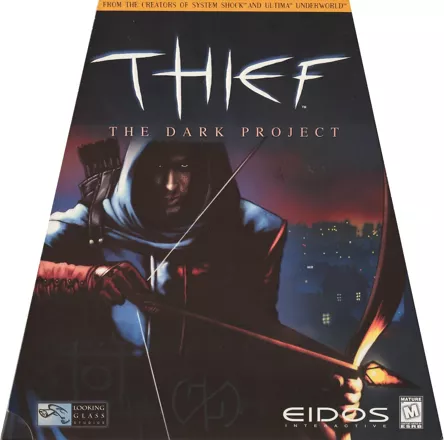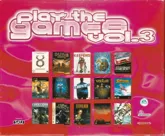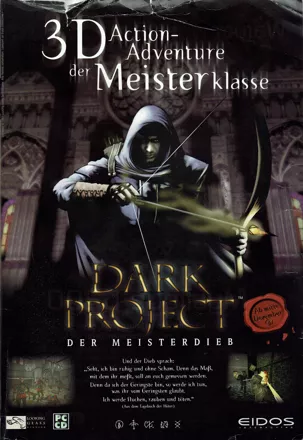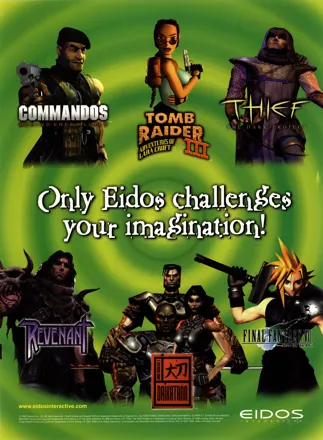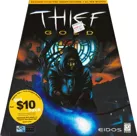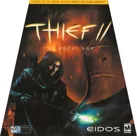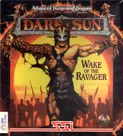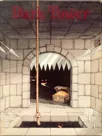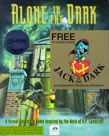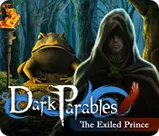Thief: The Dark Project
Description official descriptions
Garrett, discovered on the streets as a beggar, is taken in and trained by the secretive organization known as the Keepers. However, Garrett's plans for his training is different than that of his masters and so Garrett soon parts company. Surfacing as a master thief, Garrett must enter forbidden places and appropriate the treasures of the rich and the powerful. Of course this line of work is offensive to many people including the rich nobles, the town guard and the religious order of the Hammerites. If Garrett can keep his head while he relieves these forces of their valuable trinkets, he should be able to do quite well....
Thief: The Dark Project is a first person game focused on stealth. It is set in a metropolis called "the City", a medieval fantasy world with some elements from the industrial revolution era of technology. Garrett's main skills are in using the shadows to avoid being seen (the level of visibility indicated by a "light gem") and to avoid being heard (different surfaces make different noises). Guards can be alerted by either, and remaining hidden is ever important. Entering combat against armed opponents is not recommended, though some enemies (notably the various undead) can be taken on directly or avoided. It is also possible to silently sneak on guards, incapacitate them with the blackjack, steal their keys, and move their bodies.
At Garrett's disposal is a wide range of equipment, including lockpicks, a blackjack, a sword, flash bombs, holy water, explosive mines, and a bow which fires normal arrows in addition to water, fire, moss, rope, and noisemaker arrows. Each type of arrows has a unique purpose: water extinguishes torches, moss covers the ground to soften the sounds of footsteps, ropes can be used to climb in certain spots or cross chasms, etc.
The levels in the game are fairly open, and most of the time there are several paths and ways to accomplish the objective. Certain objects can be interacted with, moved from place to place, or destroyed. The game has three difficulty levels distinguished by the amount of goals needed to fulfill. Lower difficulty levels may allow the player to skip some of the harder areas due to the lack of a mission objective leading there. On higher difficulties, additional requirements (such as completely non-lethal way of finishing a stage) may be added. Loot gained from Garrett's thieving can be used to purchase additional equipment for the mission ahead.
Spellings
- 神偷 - Simplified Chinese spelling
Groups +
- 3D Engine: Dark Engine
- Game feature: In-game screenshot capture
- Gameplay feature: Body dragging
- Gameplay feature: Drowning
- Gameplay feature: Lock picking
- Gameplay feature: Pickpocketing
- Games with downloadable official map/level editors
- Green Pepper releases
- Setting: Church / Monastery
- Theme: Zombies
- Thief series
Screenshots
Promos
Videos
Add Trailer or Gameplay Video +1 point
See any errors or missing info for this game?
You can submit a correction, contribute trivia, add to a game group, add a related site or alternate title.
Credits (Windows version)
144 People (125 developers, 19 thanks) · View all
| Project Leader | |
| Lead Programmer | |
| Additional Programming |
|
| Lead Artist | |
| Lead Designer | |
| Himself | |
| Programmers | |
| Renderer | |
| Hardware Rendering and D3D Support | |
| Designers | |
| [ full credits ] | |
Reviews
Critics
Average score: 91% (based on 35 ratings)
Players
Average score: 4.1 out of 5 (based on 176 ratings with 15 reviews)
An excellent game which defined a genre.
The Good
Being sneaky was not generally a priority in early first-person games. The famous "Doomguy" from the Doom games readily mowed down rooms packed with hell monsters with a double-barrelled shotgun and probably did not think much about trying to quietly evade them instead. Good thing, too. Who would want that in Doom? But game designers, somewhere along the way, realized that it could be fun to create a first-person environment in which the player would actually want to avoid direct combat. The result was the "first-person sneaker". And one of the earliest and best games of the genre, one which would influence the whole genre ever since, was Thief: The Dark Project.
When Thief came out, it was different than anything I had ever played. I remember getting it on a demo disc from Eidos. The first time I tried it, I was blown away. It was an experience which opened new possibilities of gaming for me.
Thief casts the player as expert rogue Garrett in a fantasy steam-punk world which resembles in many ways the middle ages. Although the world's mythology was not well fleshed out in The Dark Project, there was certainly enough information to provide distinct character. Whether reading a secret letter from a noble or listening in on a guard conversation laced with fantasy slang terms, there is a good sense of place in the game.
As a "sneaker", Thief is appropriately centered around stealth. The action is by no means fast. Rather, being slow and careful with bursts of speed at key moments tends to pay off. Garrett is not very good at direct combat, despite carrying a sword in case it should be required. If you do need to remove someone, a carefully aimed arrow or a swift smack with a blackjack is a far better way. Then quickly drag the body away before someone notices. Vanish into the shadows once again, using the interface's light indicator to show you how visible you are, to return to your business.
Atmosphere is heavy in Thief. The constant threat of being caught keeps things interesting. While observing guard routes carefully can put you ahead, longer or more complex patrols can be more difficult to predict. As a result, the game is constantly tense. Even when traversing ground already travelled, the player thinks twice about leaving the shadows.
Environments in Thief are rich and detailed, especially for their time. Exploration itself is a pleasure. The most impressive levels, perhaps, were the noble's castle with its grand decor and the magician's home with its insane design. In both cases, the player feels driven forward by the desire to see more.
A good thief will use sound to his advantage, whether by silencing himself or listening to his enemy's movements. The sound in Thief is great for its time. Certainly, it serves the purpose wonderfully.
Garrett carries a variety of tools with him to slant things to his advantage. Gadgets such as water arrows to douse lights and moss arrows to soften footsteps enhance gameplay options. There is definitely a variety of ways to achieve objectives and this keeps the game fresh throughout.
The Bad
One thing that can kill any "sneaker" game is thrusting the player into direct combat. Later in Thief, missions involving areas full of undead were frustrating and an unwelcome break in the otherwise brilliant gameplay.
Additionally, some objectives or puzzles are obscure and frustrating. This is common of older games. Nonetheless, it is a pain.
The Bottom Line
Even now, Thief is a fantastic first-person sneaker. It set forth many ideas which would become standards of the genre.
Windows · by Steelysama (82) · 2009
If you like impressing yourself with your own cleverness, this is the game for you!
The Good
1. Complex AI. Guards will chase you, will look for you if you give them the slip, and will get bored of looking if they can't find you. Dead bodies alert them to your presence, so hiding said bodies becomes a priority.
-
Open-ended gameplay. This is no railroad shooter. You must come up with your own way to achieve your objectives. Do you try a frontal assault on the Manor? Quite possible, but not advisable. Sneak in through the sewers? Maybe a rope arrow placed right there? Kill the guard? Knock him out? Distract him? There are a million ways to play the game, including the ever popular "never let them realize you're there."
-
Difficulty levels that are meaningful. Not merely content with giving you less health, higher difficulty levels mean more objectives and limitations on how you can go about it ("You're a thief, not a murderer - don't kill anyone"). You haven't played the ENTIRE game unless you've done it on Expert.
-
A unique inventory. Your bow has several types of arrows, each with a different purpose. Water arrows to douse torches (making you harder to find). Rope arrows for climbing to interesting places. Fire arrows for when something absolutely MUST go boom. Your other tools include flashbombs, lockpicks, mines, and holy water. It's up to you to use them well.
-
An amazing storyline. Set in a rich steampunk setting, you are a thief caught up in a horrible plot to destroy civilization. Which puts you in the last position any self-respecting thief wants to be: the role of hero. The voice-acting is flawless, the world is unique and alive, and the continuity is maintained with extreme precision. The smallest scroll contains a scrap of information that jives with everything else PERFECTLY. Even if the information is useless to the player.
-
The main character. Garrett is a truly unique person. Cynical and jaded, he still possesses a sarcastic streak a mile wide, resulting in some priceless dialogue.
The Bad
1. Lack of rag-doll physics means that dead bodies get thrown into weird positions, which kinda ruins the verisimilitude (oh, look it up!) . There was nothing to be done about this at the time, but it'd be nice if the source code to the game was released so the fan community could improve on the engine. It worked for Doom! -
Difficult to work with custom content. To make new missions, one must replace the existing missions. The game simply does not support loading custom content the way other games do (like Doom, for example). This doesn't affect the main game itself, so it's hard to really hold this against it.
-
Uh, I can't come up with anything else to complain about, but these lists always look best with at least three entries.
The Bottom Line
A steampunk cloak-and-dagger adventure, where a sharp mind is more important than a sharp sword.
Windows · by Saborlas (3) · 2007
Steal this one if you have to!!
The Good
Incredibly deep and exciting gameplay! Thief takes the gung-ho notion of most fps games and turns it around on it's ear by delivering a game where the emphasis is not on jumping guns-blazing on enemy territory, but in snaking and infiltrating without being detected. Results? The most deep and nerve-wrecking experience you have ever had. Nothing compares to the feeling you get when you try to sneak past a guard and suddenly a false step makes him turn around and start looking for you in the dark, coming closer and closer while you pray the small modicum of invisibility the shadows provide don't fail you; or the feel you get as you frantically pick a lock while hearing footsteps coming closer and closer... or knowing that time is running out and you have to put that guard you blackjacked somewhere safe before anyone comes by, etc. etc. etc.. I could go on, and on, and on. The fact is that Thief combines a dark and lovingly crated atmosphere with the romantic yet nerve-wrecking feeling of being a thief, you know your enemies are out there, and the only way to defeat them is to hope they don't know where you are while trying to traverse some of the most intricate and finest levels ever designed (Constantine's mansion alone deserves to be nominated as one of the best levels, ever).
Thief introduced sneaking as a viable aspect of gameplay to the world, and if you think you know what I'm talking about simply because you played Metal Gear, Hitman, No One Lives Forever or whatever, then you have no clue whatsoever. This is the one and only sneak-sim, and remains unsurpassed to this day (except by it's sequel).
To top that off, the game makes the first really, really, REALLY impressive use of 3d sound in a videogame. If you are equipped with a surround set of speakers and an EAX or similar enabled sound card, then you are in for a treat. Enough sound channels to bog down a nitrogen-cooled CRAYII make sure that each and every sfx in the game comes from it's specific spatial coordinates, and there are even fantastic effects like the echos you hear on long hallways, or corridors, etc. fully recreated for your listening pleasure.
There's also the addition of a really cool storyline which fully exploits the fantasy-steampunk atmosphere and which is told via unique cutscenes that combine cel-animation, live action, and a lot of post-production magnificence into some of the darkest, most surrealistic imagery I've ever seen since The Cabinet of Dr. Caligari. Trust me, THIS is how you do cutscenes. Not by hiring the best 3D studio animators, or getting the latest Silicon Graphics Workstations, but by making them unique visual experiences on par with the game they come with.
Also: This game has the scariest zombies EVER. You have no idea the amount of times I screamed in terror when facing those bastards!! Genius I say!!
The Bad
Well, the graphics are not the best ever. They work, but the character models are truly bad.
As mentioned, the cutscenes are some of the best I've ever seen, but unfortunately they were digitized at a lousy resolution, resulting in a lot of blurryness when blown-up for fullscreen playback, a real shame.
Other than that the only real gripe I have with the game is that it relies a lot on dungeon-crawling. There's a lot of crypts, and caverns, and catacombs going on in this game, and that really hurts this game since it is much more fun to sneak around the urban locations of the game than journeying to the lost tomb of Krakatua in search of his magic wand; which also means you have to face off a lot of monsters and truly annoying critters... They would fix all this in the sequel, but no cookie for us now.
The Bottom Line
Thief: An engrossing sneaking experience by Looking Glass Studios. Go-Fetch-NOW!
Windows · by Zovni (10504) · 2001
Discussion
| Subject | By | Date |
|---|---|---|
| Duality | hribek (28) | Mar 24, 2009 |
| What can/ could You take away (add?) | hribek (28) | Mar 22, 2009 |
| Garrett on steroids | hribek (28) | Mar 22, 2009 |
| Garret looks like Nicholas Cage? | hribek (28) | Mar 13, 2009 |
Trivia
1001 Video Games
Thief: The Dark Project appears in the book 1001 Video Games You Must Play Before You Die by General Editor Tony Mott.
Basketball
Like other Looking Glass games like System Shock and System Shock 2, this game also contains a hidden basketball court. (See Tips & Tricks for details on accessing it.)
Development
Originally, Thief was to be a game called Dark Camelot where Merlin was a time-traveler but it eventually became Thief... before that it was a game involving Communist zombies!
Editor
Thief fans requested the level editor, so Looking Glass Studios released DromEd (subsequently included on the Thief (Gold) and Thief II disks), there are now hundreds of fan missions available for download.
Hammerites
"The Hammer of Light" in the game are a group of religious warrior/knights, similar to the Knights Templar during the height of their power in Europe
Inspiration
Members of the design team have said that books by Umberto Eco (The Name of the Rose among others) were a big inspiration for the atmosphere and setting of the game.
Taffer
According to an interview made by the now defunct PC accelerator to project designer Steve Pearsall the word "Taffer", which many fans went to great lengths to define as some sort of long-lost "olden" word, was actually created by level designer Laura Baldwin. It was originally meant to be some sort of slang for common criminal but it evolved from that point on.
Thievery
There is a group of people working on a free Thief inspired conversion for Unreal Tournament. It can be accessed it from http://www.thieveryut.com.
Awards
- Computer Gaming World
- April 1999 (Issue #177) – Runner-up as Best Action Game of the Year
- GameSpy
- 2001 – #40 Top Game of All Time
- GameStar (Germany)
- Issue 12/1999 - #45 in the "100 Most Important PC Games of the Nineties" ranking
- Issue 03/2000 - Most Innovative Game in 1999
- Issue 12/2008 - One of the "10 Coolest Levels" (For "The Sword". It uses the player's expectations against him - instead of the usual quick burglary, it sends him on a horror trip which manages to wear out Garret's earned self-confidence.)
- PC Gamer
- April 2000 - #27 in the "All-Time Top 50 Games Poll" (tied with Tribes)
- PC Player (Germany)
- Issue 01/2000 - Best 3D Stealth Game in 1999
- Power Play
- Issue 02/1999 – Best Action-Adventure in 1998
Information also contributed by Jack Lightbeard, Neon Hammerite, PCGamer77, Scott Monster; WildKards and Zovni
Analytics
Upgrade to MobyPro to view research rankings!
Related Sites +
-
The Circle of Stone and Shadow
A huge fan network dedicated to the Thief Series. Including everything from user-crafted levels to fan fiction. If it is Thief-related, odds are that you'll find it here. -
Thief: The Dark Project
Official Website
Identifiers +
Contribute
Are you familiar with this game? Help document and preserve this entry in video game history! If your contribution is approved, you will earn points and be credited as a contributor.
Contributors to this Entry
Game added by robotriot.
Additional contributors: Trixter, blade51, Zovni, Indra was here, Rantanplan, Shoddyan, sfabien, Jack Lightbeard, Havoc Crow, Ms. Tea, Kidofthecentury, Patrick Bregger, FatherJack.
Game added November 1, 1999. Last modified March 27, 2024.
